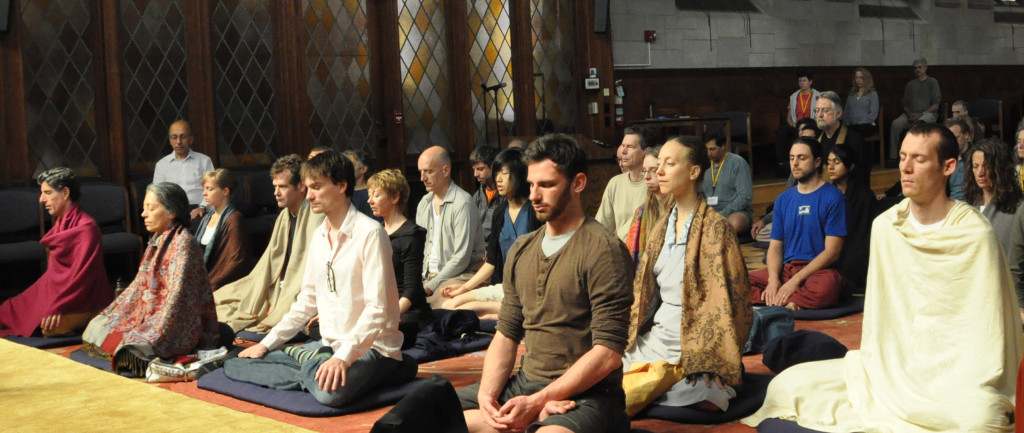
When I explain to someone that I’m involved in research on meditation, it’s not uncommon for me to hear, “Oh, meditation—I tried that. I couldn’t do it.”
This response brings up a mix of emotions in me that is equal parts sadness and frustration, with a heaping dose of motivation on top.
Sadness because people have experienced meditation in a negative light and come to associate it with a sense of failure. Frustration because that association often stems from pervasive cultural misunderstandings about what meditation is (and how it should feel when you practice). And motivation: to change this misperception, so those who are interested can experience the benefits that accompany a meditation practice.
If you do a quick online image search on meditation, what you’ll find is a popular depiction: people sitting cross-legged, eyes closed, seemingly serene and free of thoughts, some even with beams of light shooting out of their heads. You need only ask someone who meditates regularly to know that this image is a far cry from the reality of meditation. Especially for beginners.
On the outside, the body may be calm (and even that can take quite some time to achieve), but on the inside, the mind is often a messy jumble of thoughts and emotions. That’s normal. In fact, while meditation means many things to many people, from my perspective, it is not about achieving a blissed out, “empty” state of mind. Cessation of thinking is possible (or so I hear), but I see this as more of a side effect, if and when it ever occurs. To me, meditation is actually a process—one of investigating your own mind and changing the way you relate to your thoughts.
In Western society, the first style of meditation that is often taught, called mindfulness or focused attention practice, involves trying to maintain your attention on the feeling of your breath. Just that, and usually five to 10 minutes to start. Even this, however, is easier said than done. Try it and see. You’ll almost immediately be faced with any number of thoughts popping up and drawing your attention away from the breath: a recent disagreement, grocery lists, a craving for coffee, nervous excitement about an upcoming date…. This is natural. Thoughts and associated emotions arise. At some point you notice that your mind has veered off, and you disentangle yourself from that distracting train of thought, and come back to the breath. And then it happens again. And again. And again.
The struggle with meditation typically arises because our goals are misplaced. What’s easily confused is that the instructions for meditation are in fact not the goal of meditation. In other words, while we aim to maintain focus on the breath, the goal is really to learn about our minds. We do this by setting up the conditions for thoughts to arise, and then observe them non-judgmentally. Once we understand that thoughts are supposed to arise, and are even necessary for the process to be meaningful, we can relax into allowing this to happen. With practice, we begin to realize that thoughts and emotions that naturally arise will also naturally pass away. We realize they don’t always need to be acted upon, and that they aren’t as “real” as they seem.
Over the past decade, neuroscientists like myself have become increasingly interested in studying how meditation affects the brain and body. The number of studies conducted per year in this new field of contemplative science is rising exponentially, with more than 200 studies published last year alone.
What’s all the hype about?
Well, the research to date has shown many benefits of meditation, from enhancing attention and increasing test scores, to reducing stress and boosting immune function. As the field continues to blossom, and clinical studies become increasingly rigorous—employing gold-standard methodology like active controls and randomization—we are gaining a more refined understanding of the best application of contemplative practice. In other words, what styles of practice work best, to what ends and for which populations? Cognitive models are also beginning to be put forth about how meditation works psychologically, an important step for framing future research that will give us a clearer map of the mind. And moving beyond the psychological, researchers are seeking to clarify how cognitive and neural changes brought about through meditation can extend to our physical bodies, making us more healthy and resilient in response to the stresses of the modern world.
Although people seem to think the ability to meditate is part of one’s DNA—you can either do it or you can’t—like most skills, the cognitive capacities for meditation can be trained. Supporting thousands of years of anecdotal evidence from contemplative traditions like Buddhism, modern science is now showing this in its own way. Just like going to the gym and lifting weights will build your muscles, when you repeatedly practice a mental skill—be it focusing your attention, doing arithmetic, or learning a language—you build circuits in your brain. What science is proving time and again is that with intention and diligent practice, you can literally change your brain.
This understanding has been a revolution for neuroscientists and psychologists who thought for decades that the brain was fairly “fixed” after late adolescence. Most believed it was still possible to learn new information, but in terms of personality and innate potential, a human brain was thought to be hardwired around age 20. Of course, there will always be limitations given by the interplay of genes and environment, but for most of us, the window of possibility is much wider than previously believed. Meditation, it turns out, can play a significant role in brain “plasticity.”
Studies examining brain structure have found that meditation is associated with increased gray matter density, increased cortical thickness, and increased integrity of connections between brain regions important for cognitive control. Recent work shows that the more hours someone has meditated, the more cortical folding of the insula—an area important for autonomic, emotional, and cognitive integration. Some of my own research found that more experienced meditators had increased coherence of brain activity within attention networks, and also between attention control regions and areas involved in mind wandering. This would suggest both a trainable ability to concentrate, and to “let go” of intrusive thoughts.
Science aside, what the reality of meditation practice ultimately means is that you can teach an old dog new tricks. The process takes time and a good deal of dedication and effort, but with practice, you can develop a new way of relating to your thoughts and emotions. And that means it is actually possible to choose how you think, and by extension, who you are.
But don’t take my word for it. The Buddha himself told his students not to accept something simply because an authority says it’s true; rather, test it out and see if it agrees with your own experience. I’d wager that if you give meditation a serious try, you’ll see—and feel—the benefits for yourself.


